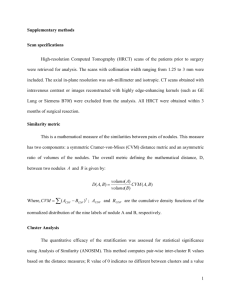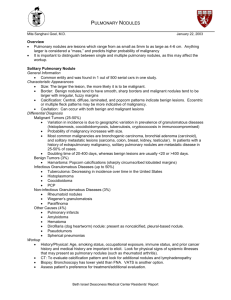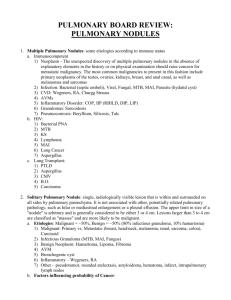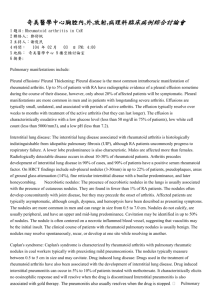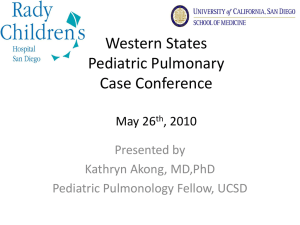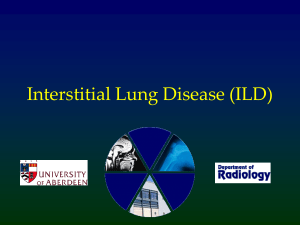fundamental and clinical evaluation of chest computed tomography
advertisement
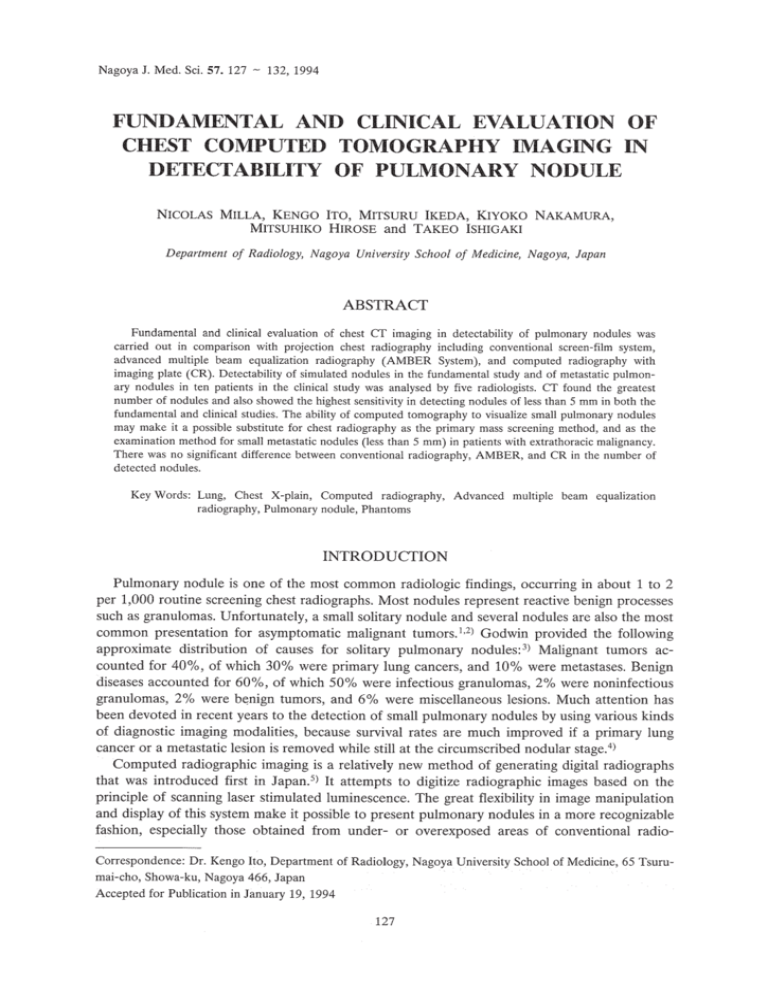
Nagoya J. Med. Sci. 57. 127 - 132,1994 FUNDAMENTAL AND CLINICAL EVALUATION OF CHEST COMPUTED TOMOGRAPHY IMAGING IN DETECTABILITY OF PULMONARY NODULE NICOLAS MILLA, KENGO ITO, MITSURU IKEDA, KIYOKO NAKAMURA, MITSUHIKO HIROSE and TAKEO ISHIGAKI Department of Radiology, Nagoya University School of Medicine, Nagoya, Japan ABSTRACT Fundamental and clinical evaluation of chest CT imaging in detectability of pulmonary nodules was carried out in comparison with projection chest radiography including conventional screen-film system, advanced multiple beam equalization radiography (AMBER System), and computed radiography with imaging plate (CR). Detectability of simulated nodules in the fundamental study and of metastatic pulmonary nodules in ten patients in the clinical study was analysed by five radiologists. CT found the greatest number of nodules and also showed the highest sensitivity in detecting nodules of less than 5 mm in both the fundamental and clinical studies. The ability of computed tomography to visualize small pulmonary nodules may make it a possible substitute for chest radiography as the primary mass screening method, and as the examination method for small metastatic nodules (less than 5 mm) in patients with extrathoracic malignancy. There was no significant difference between conventional radiography, AMBER, and CR in the number of detected nodules. Key Words: Lung, Chest X-plain, Computed radiography, Advanced multiple beam equalization radiography, Pulmonary nodule, Phantoms INTRODUCTION Pulmonary nodule is one of the most common radiologic findings, occurring in about 1 to 2 per 1,000 routine screening chest radiographs. Most nodules represent reactive benign processes such as granulomas. Unfortunately, a small solitary nodule and several nodules are also the most common presentation for asymptomatic malignant tumors. 1,2) Godwin provided the following approximate distribution of causes for solitary pulmonary nodules: 3 ) Malignant tumors accounted for 40%, of which 30% were primary lung cancers, and 10% were metastases. Benign diseases accounted for 60%, of which 50% were infectious granulomas, 2% were noninfectious granulomas, 2% were benign tumors, and 6% were miscellaneous lesions. Much attention has been devoted in recent years to the detection of small pulmonary nodules by using various kinds of diagnostic imaging modalities, because survival rates are much improved if a primary lung cancer or a metastatic lesion is removed while still at the circumscribed nodular stage. 4) Computed radiographic imaging is a relatively new method of generating digital radiographs that was introduced first in Japan. S) It attempts to digitize radiographic images based on the principle of scanning laser stimulated luminescence. The great flexibility in image manipulation and display of this system make it possible to present pulmonary nodules in a more recognizable fashion, especially those obtained from under- or overexposed areas of conventional radioCorrespondence: Dr. Kengo Ito, Department of Radiology, Nagoya University School of Medicine, 65 Tsurumai-cho, Showa-ku, Nagoya 466, Japan Accepted for Publication in January 19, 1994 127 128 Nicolas Milia et at. graphs. 6 ,7) Research efforts for improving the quality of the chest radiograph based on the use of equalization methods have resulted in the development of an advanced multiple beam equalization radiography system, AMBER, which controls local exposure delivered to the film, improving the detectability of nodules positioned over the mediastinum or diaphragmatic areas without overexposure of the lungs. 8 ,9) Since CT offers a higher degree of discrimination of tissue density than conventional radiographs, and because this is useful for detecting calcification within a nodule, CT has been applied to distinguish benign from malignant nodules. 3) Unfortunately, since neither diagnostic imaging method is tissue specific,IO) the relative specificity of each procedure in differentiating benign processes, such as granulomas from metastatic deposits or primary lung cancer if the nodule in question does not contain a nidus of calcification, is purely a function of its size "sensitivity". The lack of tissue specificity in distinguishing benign from malignant nodules, particularly in the 3 to 6 mm range, is the single most limiting factor in the evaluation of pulmonary nodules by CT. However, CT is of greater benefit in patients with metastatic tumors especially because metastatic lesions tend to be subpleural, a region difficult to examine by plain radiographyy,12) Pulmonary resection for metastatic disease has proved effective in obtaining 35% five-year survival. 13 ) The superior sensitivity of CT in the detection of metastatic pulmonary nodules may have an impact on clinical management. The purpose of this study was to compare the detectability of pulmonary nodules between projection chest radiographs including conventional chest X-plain, advanced multiple beam equalization radiography (AMBER System), computed radiography and computed tomography and to determine their usefulness. Until now there has been no comparative study between these four modalities of imaging. MATREIALS AND METHODS 1. Phantom study A chest phantom with simulated pulmonary nodules underwent three kinds of projection radiographs, that is, conventional radiography, AMBER (Philips, Oldelft, The Netherlands) and computed radiography with imaging plate (model TCR 3030 A, Toshiba, Japan). The anthropomorphic phantom used here to reproduce the human chest, was made using epoxy resin plastics of various compositions that duplicate the shape and the X-ray density of the chest structures. Computed tomography (model 900S, Toshiba, Japan) was also undergone by another specially designed phantom which reproduces transverse sections of the thorax, using compressed carton and epoxy resin plastics that duplicate the shape and CT density of the lung parenchyma, bronchus and vessels within each section. Three sections, one in the upper, one in the middle and another one in the lower thorax, were found to be sufficient to simulate most clinical situations. The simulated nodules were made of Mix DP (a mixture of parafin, polietilen, pine oil, Mg02, and Ti02). There were 25 nodules ranging from 1 to 5 mm in diameter. The nodules were attached at random on the front of the chest phantom, and inside of each transverse section in the CT phantom. Five radiologists observed four kinds of images and answered the location and size of each nodule based on the confidence of each perceived nodular opacity. 2. Clinical study Between June 1991 and September 1992, 10 patients with multiple metastatic pulmonary nodules underwent conventional chest radiography and other imaging modalities including AMBER, CR, and CT. All patients gave informed consent before participating. Conventional chest images, AMBER, and computed radiography (CR) were taken with 80 kVp tube voltage and CT was performed with 140 kVp tube voltage and contiguous 129 COMPUTED TOMOGRAPHY OF PULMONARY NODULE lO-mm thick slice without contrast material from the apex of the lung through the lung bases with an average of 20 to 25 slices per one chest study. Assessments of the images were made by five radiologists independently of each other. Each was asked to locate, count and measure the observed nodules on an image in each radiographic image and on multiple CT images. Then the nodules were measured according to the CT scale, CR scale, and by direct measurement in AMBER and conventional chest plain film. If some CT slices included the same nodule, the largest image was counted and measured. The date analysis was done by means of two-way analysis of variance (ANOVA), a method developed by R.A. Fisher, which is used most frequently to test the null hypothesis that there is no difference in the means of the populations from which the separate samples have been drawn. 14) RESULTS 1. Phantom study The outcome of counted nodules in the phantom study is shown in Table 1. We used the two-way analysis of variance to determine which method was superior in detecting lung nodules. The two-way analysis of variance showed that the detectability of pulmonary nodules was significantly different among the imaging modalities (p<O.OOOI). In all cases, the number of nodules detected with CT was shown to be greater than that detected with the other modalities. Conventional radiography detected fewer nodules than computed radiography and the AMBER system; however, the difference was not statistically significant. Table l. Total Number of Nodules Detected with Each Modality per Size in the Phantom Study Mod/Size 5mm CT 25 14 CR AMBER Plain X-p 17 12 4mm 3mm 2mm Imm Total 25 18 6 3 1 8 2 2 0 76 29 28 21 7 6 8 0 0 0 0 2. Clinical study The result of the relation between the size and total number of counted nodules is shown in Fig.l, and Table 2 shows the mean and confidence interval of the number of counted nodules. The two-way analysis of variance with no repeated measures showed that imaging modalities had a statistically significant relationship with the detectability of pulmonary nodules (P<O.OOOI), and that observers had no statistically significant relationship with it. The number of detected nodules was the largest with CT. There were significant differences in the number of detected nodules of less than 6 mm, and between 6 to 10 mm. However, there were no significant differences among the four kinds of imaging modalities in the number of detected nodules at the size of 11 to 20 mm, 21 to 30 mm, and more than 30 mm. Furthermore, there was no marked difference between conventional radiography, AMBER, and computed radiography in the number of detected nodules. 130 Nicolas Milla et al. Size of nodule (mm) <6 610 ~~ CONVE: - 21 - '" CR 30 , Table 2. Modality XCT AMBER Plain X-ray CR :~ AMBER: 30>~' Fig. 1. 1955 XCT:~ 10 10 10 10 Relation between the size and total number of counted nodules for each imaging modality in the clinical study. Mean, Standard Error and Confidence Level of Counted Nodule Number Mean ± Standard Error Confidence level (95 %) 989.2± 89.9 416.2 ± 51.9 851.2-1127.2 278.2-554.2 453.6± 40.3 419.2± 33.8 315.6-591.6 281.2-557.2 DISCUSSION The Superior sensitivity of cr in the detection of metastatic pulmonary nodules was documented soon after cr's introduction. In addition to its advantageous cross-sectional display of anatomy and high contrast, spatial resolution of cr allows detection of pulmonary nodules as small as 2 mm in diameter. In a pathologic study by Crow et aI.,l1) 59% of metastatic lesions measured 5 mm or less, a size rarely detected with standard radiography. Conventional screenfilm systems provide excellent spatial resolution and specificity; however, the requirement of wide latitude can not be met without sacrifice of contrast. In addition, conventional chest radiography is limited by scatter radiation, particularly in the mediastinum and heart. The experience of Muhm and associates at the Mayo Clinic,15) indicates that cr can, in fact, detect more nodules than either chest radiography or conventional whole lung tomography. This is primarily because the normal superimposition of bony or vascular structures inherent in conventional film examinations is avoided entirely with cr scanning. The orientation of the cr scans is particularly well suited for the demonstration of lesions peripherally located within the lungs, those in the costophrenic angles, retrosternal or retrocardiac regions, and high in the apices. Recent development of medical electronics has made it possible to realize dedicated plain radiography sys- 131 COMPUTED TOMOGRAPHY OF PULMONARY NODULE tems such as CR and AMBER system. These modalities improve the detectability of nodules as compared with conventional radiography with screen-film system. 6.9) However, they are less sensitive in detecting a small pulmonary nodule than CT as shown in this study. The main reason why more and smaller nodules can be detected by CT than other modalities is that CT has higher contrast resolution and the transverse orientation of the CT image eliminates the confusing shadows caused by superimposed cardiovascular and bony structures. Our clinical study shows that there are no significant differences in the number of detected nodules by conventional radiography, computed radiography and AMBER. This can be explained by the fact that most of the pulmonary nodules were located over the lung compared with few nodules over the mediastinum and diaphragmatic areas, where the ability of computed radiography and AMBER to detect nodules is greatly improved compared with conventional radiography.16) We have been able at the same time to confirm the importance of CT in the management of patients with pulmonary nodules by using a reference phantom system. In the phantom study there was no significant difference in the number of nodules detected by conventional radiography, computed radiography and AMBER, because of a situation similar to that in the clinical study: most of the pulmonary nodules were also positioned over the lung, where the ability to detect nodules by computed radiography and AMBER is only slightly improved compared with conventional radiography. 16) In this study, it is clear that CT is a highly sensitive method for detecting more and smaller pulmonary nodules than the other modalities. The ability of CT to visualize small pulmonary nodules may make it a possible substitute for chest radiography as the primary screening method, including mass screening, in evaluating patients for early pulmonary malignancy. However, reduction of radiation dose in CT examination is needed for it to be used in mass screening. This may be possible by using the CT spiral method I?) in which 20 slides are obtained in 24 seconds in only one held-breath exposure. Since the highest permissible milliampere-second setting for a spiral scan is currently less than that used for standard CT, the radiation dose to the patient is currently less for spiral CT. Further investigation is needed to realize CT as a screening system. 18) ACKNOWLEDGMENTS The authors are grateful and appreciate the help of the radio-technicians of the Department of Radiology at the Nagoya University Hospital for their technical assistance; to the radiology staff and radiology residents at the Nagoya University Hospital for their participation in the observer study; to Sadayuki Sakuma, MD, for his support and advice at the beginning of this project. We also thank Mrs. Sobajima for her secretarial assistance. REFERENCES 1) 2) 3) 4) 5) Steele, J.D.: The solitary pulmonary nodule: Report of a cooperative study of resected asymptomatic solitary pulmonary nodules in males. J. Thorac. Cardiovasc. Surg., 46, 21-39 (1963). Toomes, H., Delphendahl, A., Milne, H.G., Manke, H.G. and Vogt-Moykopf, 1.: The coin lesion of the lung: A review of 955 resected coin lesions. Cancer, 51, 534-537, (1983). Godwin, J.D.: The solitary pulmonary nodule. Radio. Clini. North Am., 21, 709-719 (1983). Niklason, L.T., Hickey, N.M., Chakraborty, P., Sabbagh, E.A., Yester, M.V., Fraser, R.G. and Barnes, G.T.: Simulated pulmonary nodules: Detection with dual-energy digital versus conventional radiography. Radiology, 160, 589-593 (1986). Sonoda, M., Takano, M., Miyahara, J., Katoh, H.: Computed radiography utilizing scanning laser stimulated luminescence. Radiology, 148,833-838 (1983). 132 Nicolas MilIa et al. 6) 7) 8) 9) 10) 11) 12) 13) 14) 15) 16) 17) 18) Merritt, RB., Matthews, e.e. Tutton, RH., Miller, K.D., Bell, K.A., Kogutt, M.S., Bluth, E.1., Balter, S. and Kalmar, J.A.: Clinical application of digital radiography: Computed radiographic imaging. Radio Graphics, 5,397-414 (1985). Sheline, M.E., Brikman, 1., Epstein, D.M., Mezrich, J.L., Kundel, H.L. and Arenson, RL.: The diagnosis of pulmonary nodules: Comparison between standard and inverse digitized images and conventional chest radiographs. AiR, 152, 261-263 (1989). Vlasbloem, H. and Kool, L.J.: AMBER: A scanning multiple-beam equalization system for chest radiography. Radiology, 169,29-34 (1988). Kool, LJ., Busscher, L.T., Vlasbloem, H., Hermans, J., Merwe, P.e., Algra, P.R. and Herstel, W.: Advanced multiple-beam equalization radiography in chest radiology: A simulated nodule detection study. Radiology, 169, 35-39 (1988). Schaner, E.G., Chang, A.E., Doppman, J.L., Conkle, D.M., Flye, M.W. and Rosenberg, S.A.: Comparison of computed and conventional whole lung tomography in detecting pulmonary nodules: A prospective radiologic-pathologic study. AiR, 131, 51-54 (1978). Crow, J., Slavin, G. and Kreel, L.: Pulmonary metastasis: A pathologic and radiologic study. Cancer, 47, 2595-2602 (1981). Dinkel, E., Mundinger, A., Schopp, D., Grosser, G. and Hauenstein, H.: Diagnostic imaging in metastatic lung disease. Lung Supp!., 1129-1136 (1990). Chang, A.E., Schaner, E.G., Conkle, D.M., Flye, M.W., Doppman, J.L. and Rosenberg, S.A.: Evaluation of computed tomography in the detection of pulmonary metastases. Cancer, 43, 913-916 (1979). Dunn, O.J. and Clark, V.A.: Applied statistics. Analysis of variance and regression, edited by John Wiley & Sons, pp. 123-135 (1987), New York. Muhm, J.R., Brown, L.R, Crowe, J.K., Sheedy, P.F., Hattery, R.R. and Stephens, D.H.: Comparison of whole lung tomography and computed tomography for detecting pulmonary nodules. AiR, 131, 981-984 (1978). Wandtke, J.e., Plewes, D.B. and McFaul, J.A.: Improved pulmonary nodule detection with scanning equalization radiography. Radiology, 169, 23-27 (1988). Heiken, J.P., Brink, J.A. and Vannier, M.W.: Spiral (helical) CT. Radiology, 189,647-656 (1993). Iinuma, T., Tateno, Y. and Matsumoto, T.: Preliminary specification of X-ray CT for lung cancer screening (LSCT) and its evaluation on risk-cost-effectiveness. NIPPON ACTA RADIOLOGICA, 52, 34-42 (1992).
